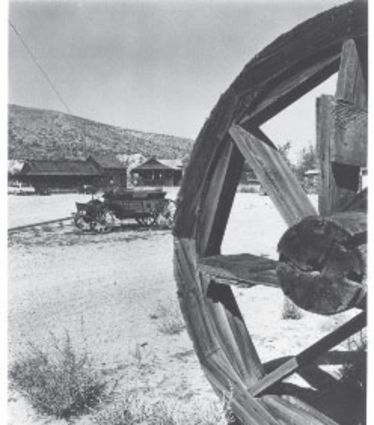Birth of a dream
A Page of History

Photo provided
You all know the drill –I scrounge through my mom Marion Deaver's stuff and I find something of hers to write about in this column.
Sometimes it can be a little more complicated than that. I found an article from January 24, 1958. My mom wrote about the opening of Burton's Tropico Gold Mine & Mill Tours in Rosamond. I was eight that year.
I found the article and remembered a photo Mom took one day that announced the beginning of the dream to open a mine camp at the base of Tropico Mine and conduct tours of the mine.
The photo showed Doreen Settle sitting and in her lap was a gold pan and some nuggets, as she and her husband Glenn Settle discussed the dream to open the camp and to bring the public in to see what mining life was like in the 1890s. When gold was discovered by Ezra Hamilton near the location of the mining camp that was going be to re-created by the Settles.
I spent 30 minutes looking for that old photo with no luck. I made a file of photos Mom took at Tropico –hundreds of them-but not the one I wanted. I did find an artistic shot of the gold camp instead. When I find the old photo while looking somewhere else in a few weeks, maybe I will run that!
Doreen was a Burton, whose brothers gradually bought up all the stock of Tropico and the original claim of Ezra Hamilton's, and operated the mine until 1956, when the price of gold was so low it was not profitable to operate any more.
Doreen married Glen Settle and over the years they collected many old mining relics and other antiques from the surrounding area. The project to create the museum, mining camp, and mine tours was that of the Settles and Mr. and Mrs. George McNamee. You notice the couple's name was Mr. and Mrs. McNamee. I do not know the wife's name. The Settles were referred to the same way, but I know Doreen's name. That was the style in the fifties –you were the missus. Oh, how times have changed...
The camp began with a museum full of artifacts, including a replica of a miner's cabin in one corner, an assay office in another, and with the walls covered with relics. Others heard about the plans and either donated or loaned other items to the project.
Outside and behind the museum was a shiny red and black antique automobile which was believed to be the last vehicle owned by Death Valley Scottie – which is a story for another day.
The project was a success and visitors flocked to the site for the tours. Especially popular was the mine tour, since few people had ever actually been in a mining tunnel. The mine tour ended at the "glory hole" and on to the mill, where the ore was processed.
Over the years the mining camp grew as other buildings were brought in. If there was a building that might be demolished the Settles agreed to have it moved to the site. There was even an old schoolhouse moved in.
As the owners of the mine and camp got older, they hired young people to conduct tours. After first Doreen and then Glenn died, the camp was eventually closed. One site on the Internet also cited high costs for liability insurance as another reason for its closure.
I do not have an exact time line for its closure, but as far as I can determine it remains closed today. Along with my parents, I spent many weekends there for events.
The last time I was there was in the early eighties as a journalist for the World Championship Chili Cook-off. I decided to get there early in the afternoon with some friends to see "everything" before the announcement of the winner at 3:30 p.m.
When I say everything I mean everything, from the wet t-shirt contest to the most consumption of beer and chili I have ever witnessed. We journalists were probably the only sober ones left when the winners were announced, and there were a lot of people there.




